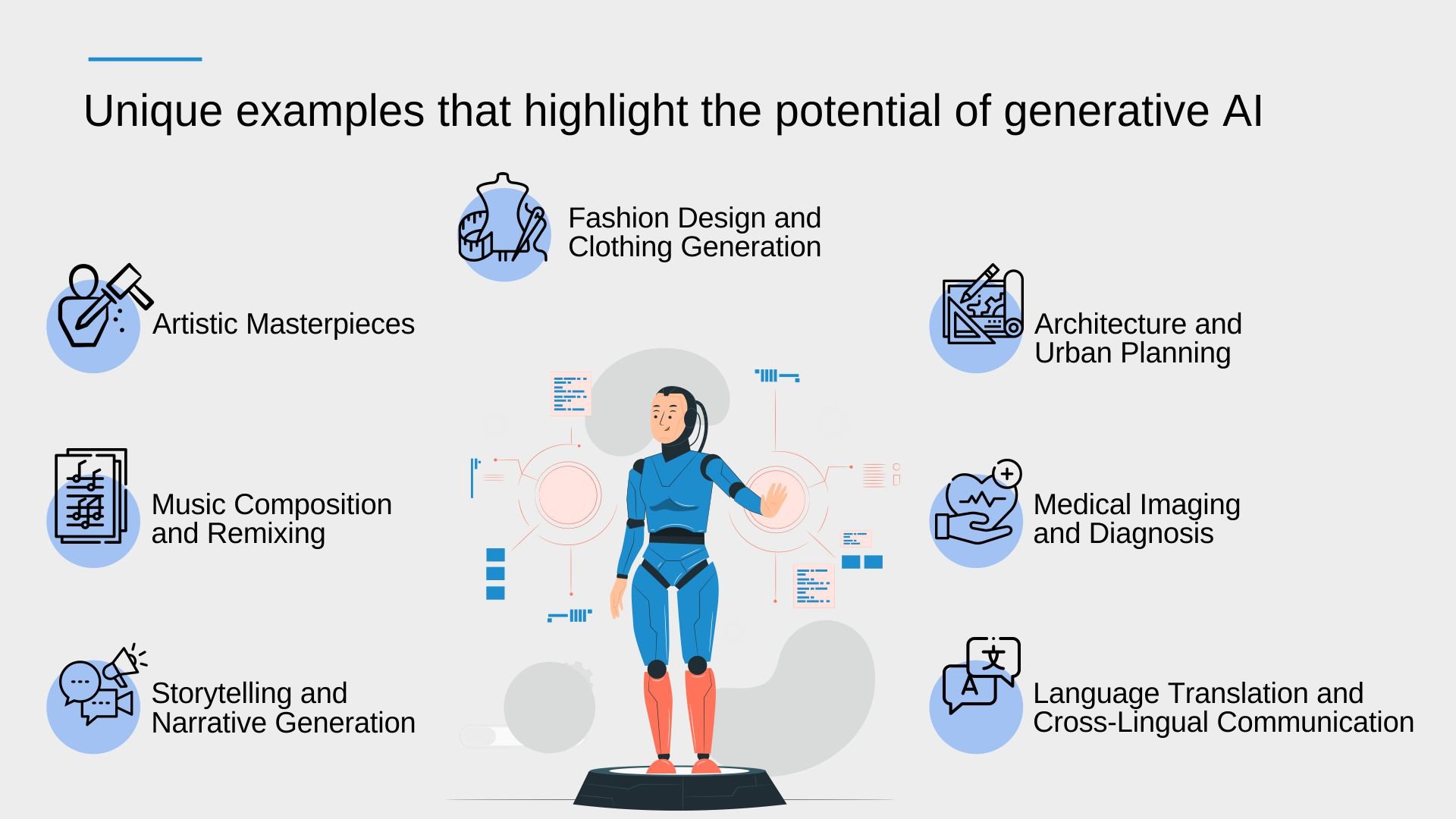Generative Artificial Intelligence (AI) has emerged as a powerful tool for creativity, enabling machines to generate original and innovative content autonomously. This groundbreaking technology has found applications across various industries, pushing the boundaries of what is possible in creative endeavors. In this blog, we will delve into a collection of unique and inspiring examples that highlight the immense potential of generative AI.

Artistic Masterpieces
Generative AI has disrupted the art world, allowing machines to create breathtaking artworks. One notable example is "Portrait of Edmond de Belamy," an AI-generated painting that was sold at an auction for a substantial sum. This artwork was created using Generative Adversarial Networks (GANs), a popular technique in generative AI. GANs learn from existing art pieces and produce new and unique compositions, blending styles and pushing artistic boundaries.
Music Composition and Remixing
Generative AI has revolutionized the way we create and experience music. Projects like Jukedeck and Amper Music have developed AI systems that can compose original music for various purposes, such as background tracks for videos and advertisements. These systems analyze patterns and genres to generate music that matches specific requirements. Furthermore, generative AI can also remix existing songs, offering endless possibilities for artists and DJs to explore new sonic landscapes.
Storytelling and Narrative Generation
An AI-powered narrative generation has the potential to transform storytelling and interactive experiences. ChatGPT, a language model developed by OpenAI, can generate engaging and contextually relevant stories, blurring the line between human and machine-authored narratives. This technology holds promise for video games, virtual reality experiences, and interactive storytelling platforms, where narratives can adapt dynamically based on user input and preferences.
Fashion Design and Clothing Generation
Generative AI is making waves in the fashion industry, enabling designers to experiment with unique designs and streamline the creative process. Companies like Glitch and H&M have utilized AI algorithms to generate new clothing designs and predict fashion trends. Generative models trained on vast collections of fashion images can generate novel and aesthetically pleasing clothing designs, assisting designers in exploring new styles and optimizing their creative workflow.
Architecture and Urban Planning
Generative AI is transforming the architectural and urban planning sectors by facilitating the generation of innovative designs and optimizing urban layouts. By training on existing architectural designs and constraints, AI models can propose novel building layouts and optimize parameters such as energy efficiency and space utilization. This technology empowers architects and urban planners to explore diverse design possibilities and create sustainable and efficient urban environments.
Medical Imaging and Diagnosis
Generative AI has immense potential in the field of healthcare, particularly in medical imaging and diagnosis. By training on large datasets of medical images, generative models can generate synthetic images that simulate various medical conditions. This aids in training and testing diagnostic algorithms, improving the accuracy of disease detection. Additionally, generative AI can be used to augment limited datasets, enabling better training of medical imaging models.
Language Translation and Cross-Lingual Communication
The field of language translation has been transformed by the advent of generative AI, which has brought about significant advancements in producing precise and contextually appropriate translations. Systems like Google Translate leverage advanced neural machine translation models to generate high-quality translations across multiple languages. These models learn from vast amounts of multilingual text data, enabling smoother cross-lingual communication and fostering global connectivity.
Conclusion
Generative AI has ushered in a new era of creativity, where machines are not only assisting but actively participating in the creative process. From art and music to storytelling and fashion design, the examples presented in this blog demonstrate the remarkable capabilities of generative AI. As technology continues to evolve, we can expect even more awe-inspiring applications, propelling human creativity to unprecedented heights. Generative AI is a testament to the power of combining human ingenuity with machine intelligence, shaping a future where AI is a collaborator and catalyst for creative innovation.
